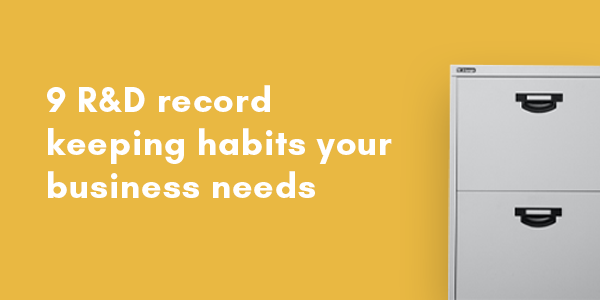Surprisingly HMRC doesn’t set out any specific record-keeping requirements when it comes to R&D tax claims. It recognises that every business operates differently and the way they keep their records will reflect this. HMRC also understands that first time claimers won’t have fully audited records. However, if you’re not first time claimers it is good practice to establish a reliable record-keeping system as early as possible. This will only improve the success, and possibly enhance the value of your claim refund. More funds means more projects and less chance of HMRC questioning your costs for eligibility.
With that in mind we want to share some good practice habits to establish in your business when it comes to record-keeping.
BUT FIRST, WHY IS IT IMPORTANT TO KEEP RECORDS?
Well, the records you keep for the time and money invested on research and development are the audit trail for your R&D Tax Relief claim. To make a claim, you need to be able to realistically prove to HMRC your expenditure. The records you keep will need to: demonstrate a systematic approach to R&D activity, evidence all qualifying spend and validate any innovations made were not ‘by chance’
1. KEEP A LIST OF PROJECTS
The simplest and most effective thing you can do, is setup a list of all the R&D projects your business has worked on over the last 12 months, including any new ones. If you’re unsure whether a project is R&D, stick it on the list and start recording. It’s better to have the information recorded when it comes to crunch and then it can be ruled it in or out.

WHAT INFORMATION SHOULD I RECORD?
Here’s an overview of the key information you should be recording for each R&D project:
2. DIRECT PEOPLE COSTS
Keep a record of time spent by directors, employees, and any other qualified staff working on R&D projects. These records will be used to apportion the salary and any other costs that can be allocated to the claim. First you’ll need to identify the projects each employee worked on during the year. Then for each project the qualifying R&D activity delivered by the employee and the time taken.
Records include:
- Salary (pension, NIC, Bonuses)
- Reimbursed Expenses (any travel, accommodation, subsistence costs related to R&D project and reimbursed via an expense claim)
- Time sheets if applicable (we will talk timesheets later!)
3. SUBCONTRACTOR COSTS
Keep a record of all subcontractors (connected and unconnected) working on any R&D projects. Connected subcontractors, are those where two companies are controlled by the same person or are part of the same group. A record should be kept for all ‘paid for’ subcontractor invoices. We’d always recommend splitting up the two categories to record connected subcontractor costs and unconnected subcontractor costs separately.
Records include:
- Invoices relating to all these costs
- Contracts
- Time sheets if applicable
4. MATERIALS & CONSUMABLES
Keep a record of costs for all materials and resources consumed as part of your R&D project, this includes materials, water, light and heat.
Records include:
- Invoices relating to all material costs
- Invoices relating to water, light and heat costs
5. SOFTWARE COSTS
Keep a record of all software licences used, specifically on the R&D project. If the software was bought for use in the R&D project only, you can claim 100% of its price. However, if the software will only be used partly in your R&D project you will need to apportion the costs.
Records include invoices relating to all these costs, and what they were used for.
6. RELATED PROTOTYPE COSTS
Keep a record of all costs linked to the design and production of a prototype needed to test the R&D project. We often see this one slip through the net!
Records include invoices relating to all these costs.
SETTING UP RECORD-KEEPING SYSTEMS
The best place to start is with the systems or processes you already have in place for record- keeping and identifying how they can be modified or enhanced to be even more accurate. Here’s some ideas for different levels of record-keeping systems you can introduce into your business processes, starting with people time.

7. PEOPLE TIME
Cloud-based timesheets
Timesheets are perfect for recording employee time spent on R&D projects and provide a great audit trail for your R&D claim. There are loads of systems such as Meistertask, Trello, Asana and Basecamp, which you can use to record and track all project related activity, including people time.
However, these systems do require commitment and rely on timesheets becoming an integral part of your culture. Employees will need to log all the activity, and the number of hours spent against a specific project. If it can be adopted, it is a really effective way to report on employees contribution to projects. We can recommend a free app called Clockify. You can report on individual employees, or teams & R&D projects and export reports.
Spreadsheets
You don’t have to go all out and integrate a cloud based timekeeping system. Spreadsheets can do the trick. You might find it easier to get started with a spreadsheet and trial whether timesheets is something that could work for your business. The same logic applies; log projects, tasks and time spent at the end of each day. Review this weekly or monthly to ensure you have recorded all time spent.
Email calendars
If your business uses Outlook or Gmail calendars to log ALL meetings and tasks, a sensible way to trial out timesheets, is by using the categories feature. Set up a colour code system for your R&D projects and when scheduling your time apply the correct colour. At the end of each week you can very quickly estimate the time spent across different projects in the business.
Project meetings
It might be that a timesheet system isn’t right for your business, but that’s okay. If that’s the case, you could use meetings as an opportunity to take minutes and record the input from employees involved in R&D projects. You could set up a weekly projects meeting, or include an R&D slot in an existing team meeting. No one likes a meeting for meetings sake.

8. OTHER R&D COSTS: MATERIALS, CONSUMABLES, SUBCONTRACTORS
For all other costs, your accounting system will become your best friend. You can easily set up R&D codes for each project within your nominal ledger. Codes can be allocated to expenses from expenditure on, materials, sub-contractors, consumables, software licenses. However, you need to make sure that the code system is clearly communicated to everyone that will be expected to use it. We have had cases where clients have taken this a little too literally and started to record EVERYTHING under the new codes! Oops! That’s one way to get an HMRC enquiry…..
9. SUBCONTRACTOR PROJECTS
Where you are using subcontractors that also work on projects outside of the scope of R&D, it’s all about communication. Agree how you would like them to identify R&D project work and ensure they stick to it. Little tips like this just make it easier to add the invoices to your system accurately using the correct code.
THINK YOU MIGHT BE ELIGIBLE TO CLAIM?
If you think you might be eligible for R&D Tax Relief, and you’d like to find out more about how we can help you make your R&D claim, please book a call here.
Partners with Radish Tax
We’ve partnered with Radish Tax by Diagnostax – a specialist R&D Tax Relief provider. Tim & the team at Radish Tax are friendly, easy to work with and make the process of claiming R&D Tax Relief painless.
Find out more about Radish Tax by Diagnostax.

